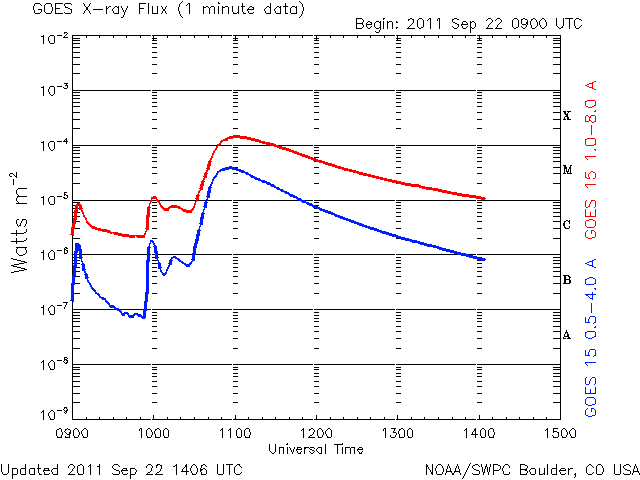There was a solar flare this morning, starting at around 1030 UTC and peaking at a level of X1.4 at around 1100 UTC.
Solar flares are sudden bright areas that appear on the Sun. They emit a large burst of energy at various wavelengths, including x-rays, as the graph below shows:

A movie of the flare is available here: http://sdowww.lmsal.com/sdomedia/h264/2011/09/22/SSW_cutout_20110922T1024-20110922T1159_AIA_211-193-171_N09E89.mov
They also eject a large number of charged particles, such as electrons and protons. The effect of the x-rays is immediate, as soon as they reach the Earth (taking about 9 minutes at the speed of light) they cause a sudden increase in ionization of the ionosphere, but not in a good way. The D layer, which attenuates radio waves, rather than reflecting them, becomes strong enough to block large portions of the HF band. The D layer is what prevents long distance reception of MW signals during the daytime. With a stronger D layer, due to the flare, this attenuation moves up into the HF bands as well.
Depending on the intensity of the flare, frequencies to 10, 15, or 20 MHz, or possibly even the entire HF spectrum, can be completely blocked. The effect is only present on the portion of the ionosphere in daylight, nighttime areas are not affected. As I type this, at 1400 UTC, CHU on 3330 is completely absent. The x-ray levels are down to about the M1 level now, earlier I suspect higher frequencies were being attenuated as well.
Solar flares are categorized by their intensity at x-ray wavelengths. A log type scale is used, much as for earthquakes. An X1 flare is ten times as strong as an M1 flare, which is ten times as strong as a C1 flare, for example. Within each letter, numbers are used to further classify the intensity. An M2 flare is twice a strong as an M1 flare. An X1 flare would be equivalent to an M10 flare, if such a designation existed.
Although strong solar flares can be highly disruptive to HF, they do allow the reception of some signals that would otherwise be difficult to receive, depending on the various locations of the stations and your QTH. A flare could cause the signal from the dominant station on a particular frequency to be heavily attenuated (if the path between your location and that station is in the sunlight portion of the Earth), while allowing another station (if the path to that station is in darkness) to be received.
Realtime solar x-ray flux values, as measured by the GOES weather satellites, are available at this link: http://www.swpc.noaa.gov/rt_plots/xray_1m.html
There is also a graph with a slower (5 minute vs 1 minute) update rate here: http://www.swpc.noaa.gov/rt_plots/xray_5m.html
This particular flare was on the limb of the Sun, so any charged particles ejected by it are not likely to be directed to the Earth. When flares do produce Earth directed CMEs (Coronal Mass Ejections), the charged particles often produce geomagnetic storms when they reach the earth, producing aurora, and degrading MW and HF radio reception, for hours or even days.

Hi There Chris Smolinski,
This might be off topic, however, On 8th September 2010, the Sun unleashed a massive solar flare aimed over an array close to our planet. Luckily, we had escaped such a seemingly dreadful devastation as it would have caused maybe a lot more than just the expected bright auroras of hot light.
Keep up the posts!